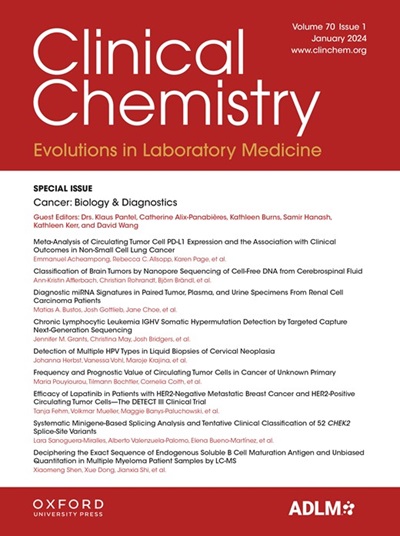B-184 从零下 20°C 保存长达 1.5 年的冷冻血液样本中纯化高质量基因组 DNA
IF 7.1
2区 医学
Q1 MEDICAL LABORATORY TECHNOLOGY
引用次数: 0
摘要
背景 从运输、储存到处理,保持血液样本中 DNA 的完整性对下游应用的成功至关重要,尤其是在诊断应用方面。此外,由于采集血液样本具有侵入性,因此必须考虑尽量减少再次采样,以避免给病人带来过多痛苦,并降低采集和运输成本。选择在冷冻室中存储和保存部分血液样本,可以在未来进行重新检测,而无需重新采集。与 -80°C 冷冻机相比,-20°C 冷冻机通常更经济实惠、能耗更低、占地面积更小,因此,证明冷冻血液在 -20°C 温度下的稳定性可以减轻设施有限的实验室的采样负担。方法 将健康献血者的全血采集到 9mL 真空管(HemaSure-OMXP)中。冷冻全血样本在 0 天、49 天、141 天和 148 天时进行处理,冷冻水溶液样本在 7 天、27 天、36 天、185 天、246 天、373 天、394 天、584 天和 604 天时进行处理。纯化的 gDNA 用 Qubit(Broad Range dsDNA Assay,ThermoFisher)定量,并用 Nanodrop One Microvolume UV-Vis Spectrophotometer(ThermoFisher)和 TapeStation(Genomic DNA ScreenTape,Agilent Technologies)鉴定。结果 观察发现,新鲜和冷冻全血样本的 DNA 产量和质量没有明显下降。新鲜和冷冻的 200 μL 全血平均 DNA 产量分别为 4.5 ± 2.2 μg 和 5.3 ± 1.2 μg。新鲜和冷冻血液的平均 DNA 完整性(DIN)分别为 6.9 ± 0.4 和 7.1 ± 0.3。献血者血液样本的差异有助于解释所报告的 DNA 产量差异。在-20°C下冷冻更长时间的水溶液样本的DNA产量和质量没有明显下降。本研究共处理了 84 份全血样本和 25 份水溶液样本。结论 虽然由于白细胞含量较高,水溶液样本的产量往往高于全血样本,但两种样本都能为下游应用提供足量的 gDNA。在不影响核酸产量或新鲜样本质量的前提下,将血液样本冷冻以备将来检测,可有效减少重新采样的需要。此外,随着设备和检测技术的进步,冷冻血液样本可以重新进行检测,并与之前的结果进行比较,以改进诊断决策,而无需实验室和患者重新进行回忆。本文章由计算机程序翻译,如有差异,请以英文原文为准。
B-184 Purifying High-Quality Genomic DNA From Frozen Blood Samples Stored up to 1.5 Years at -20°C
Background Maintaining DNA integrity in blood samples, from transport to storage to processing, is crucial to the success of downstream applications, especially regarding diagnostic applications. Additionally, due to the invasive nature of collecting blood samples, minimizing resampling to avoid excess patient pain and cost of collection and transportation are important to consider. Having the option to store and maintain portions of blood samples in the freezer enables future retesting without recollection. Since -20°C freezers generally are more affordable, require less energy, and have smaller footprints than -80°C freezers, demonstrating frozen blood stability at -20°C temperatures could decrease sampling burdens for labs with facility constraints. Methods Whole blood was collected into 9mL vacuum tubes (HemaSure-OMXP) from healthy donors. Aliquots of whole blood and buffy coat samples were stored at -20°C and thawed for genomic DNA extractions (QIAamp DNA Blood Mini Kit, Qiagen) at a range of different timepoints; frozen whole blood samples were processed at 0, 49, 141, and 148 days and frozen buffy coat samples were processed at 7, 27, 36, 185, 246, 373, 394, 584, and 604 days. Purified gDNA was quantified with Qubit (Broad Range dsDNA Assay, ThermoFisher) and qualified with Nanodrop One Microvolume UV-Vis Spectrophotometer (ThermoFisher) and TapeStation (Genomic DNA ScreenTape, Agilent Technologies). Results No significant decrease was observed for DNA yield and quality between fresh and frozen whole blood samples. Average DNA yields from 200 μL whole blood were 4.5 ± 2.2 μg and 5.3 ± 1.2 μg for fresh and frozen blood respectively. Average DNA integrity (DIN) was 6.9 ± 0.4 and 7.1 ± 0.3 for fresh and frozen blood respectively. Donor differences in blood samples can help explain the variance in DNA yields reported. No significant decrease was observed for DNA yield and quality in buffy coat samples frozen for longer at -20°C. In total, 84 whole blood and 25 buffy coat samples were processed in this study. Conclusions Although buffy coat samples tended to have higher yields than whole blood, due to the higher amount of white blood cells present, both sample types provided sufficient amounts of gDNA for downstream applications. Freezing blood samples for future testing can be effective at reducing the need for resampling without sacrificing the nucleic acid yield or quality of fresh samples. Additionally, as technological advancements are made for equipment and assays, frozen blood samples can be retested and compared to previous results for improved diagnostic decisions, done without requiring recollection from labs and patients.
求助全文
通过发布文献求助,成功后即可免费获取论文全文。
去求助
来源期刊

Clinical chemistry
医学-医学实验技术
CiteScore
11.30
自引率
4.30%
发文量
212
审稿时长
1.7 months
期刊介绍:
Clinical Chemistry is a peer-reviewed scientific journal that is the premier publication for the science and practice of clinical laboratory medicine. It was established in 1955 and is associated with the Association for Diagnostics & Laboratory Medicine (ADLM).
The journal focuses on laboratory diagnosis and management of patients, and has expanded to include other clinical laboratory disciplines such as genomics, hematology, microbiology, and toxicology. It also publishes articles relevant to clinical specialties including cardiology, endocrinology, gastroenterology, genetics, immunology, infectious diseases, maternal-fetal medicine, neurology, nutrition, oncology, and pediatrics.
In addition to original research, editorials, and reviews, Clinical Chemistry features recurring sections such as clinical case studies, perspectives, podcasts, and Q&A articles. It has the highest impact factor among journals of clinical chemistry, laboratory medicine, pathology, analytical chemistry, transfusion medicine, and clinical microbiology.
The journal is indexed in databases such as MEDLINE and Web of Science.
 求助内容:
求助内容: 应助结果提醒方式:
应助结果提醒方式:


